But now a sight that just amuses,
The man who pulls a load behind
A couple sets of cloven hoov’ses
—Ike St. Pulliam
I’d like to give you a brief sketch of my journey breaking steers to be oxen. When asked by friends about my experience with the subject, I found that many of them assumed oxen were a specific breed of cattle. They wanted to know where I might have gotten my hands on such a rare breed, since they themselves had never laid eyes on any, except for the pages of National Geographic. Pretty good question for a society that, for the most part, has forgotten about using oxen in the day-to-day functions of a small farm.
Actually, oxen aren’t born; they’re made—I should probably say trained or “broke”. They’re castrated (or “cut”) males from just about any breed or species of cattle you could imagine. Traditionally, a “steer” is termed an “ox” after it reaches the age of 4. Let me tell you how I stumbled onto this old slice of farm living.

A well-broke ox, resting in the shade of his barn
Nothing to Lose but Time
After completing the construction of my first barn back in 1999, I was ready to find a suitable milk cow to inhabit it. She came in the form of a small Jersey, with two small, mostly black Jersey/Holstein bull calves that came with her in the deal. My first thought was to raise both, sell one, and dress the other out for the freezer.
My second thought was thus: Growing up I’d always been fascinated by the yokes I’d seen hanging in barn aisles…but no longer used. Well, here I was with two calves; I figured, “Why not try breaking them to the yoke? If it fails, I won’t have lost anything except time,” which I often lost every now and then anyway. I didn’t expect much success, and truth be known, was not dreading the idea of extra cash and fresh steak should the venture be a complete bust. So onward I went.
One at a Time
The first step was to separate Q-tip and T-bone (Q had a white-tipped tail, and T-bone…you know) from their nurse cow; a painful parting for all involved. I needed to be the sole focus of their attention.
First…halter training.
I made two small, rope halters out of hemp rope, and broke them to stand tied for periods of time. Next came teaching to lead. After a week, success.

All of this was done individually, with one calf, then the other…never together at this point. Then came voice commands for each calf: first “whoa” (most important command for the rest of any ox’s life), then “get up”. After just a few weeks more, more success. Then more commands—“gee” (right turn), “haw” (left turn), “back” (back), and “get over” (side stepping or moving laterally)—all while continuing to review older commands, and speaking in calming, gentle “yay’s” when they responded correctly, and in a harsher “(I can’t even spell the sound I made)” when they ignored or disobeyed me. I also carried a hickory goad (a small stick) in my hand, more for a visual cue than for the occasional correcting sting to the rear. At the beginning I walked by default more in front of them, but gradually and purposely began moving behind them as they began to learn the voice commands. Again, more weeks, more success.
I found myself not as hungry for red meat…and growing attached to the new friends under my dominion. Q, T, and me were ready for the next step. But I had no yokes. I headed for the woods.
A Simple Yoke, Done Right Quick
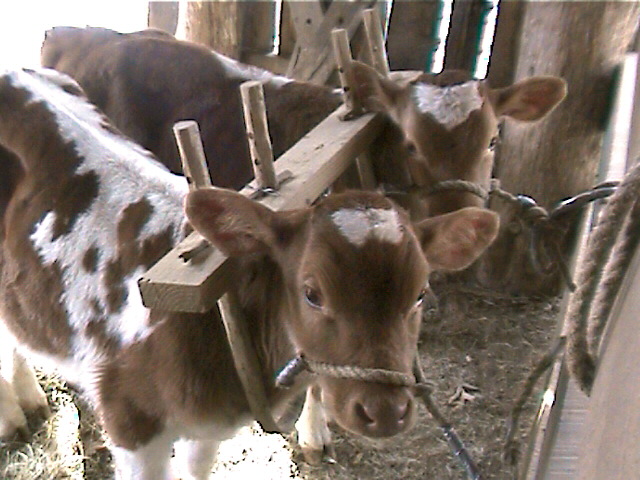
A pair of my guernsey calves, learning to stand fast, getting used to their 2 X 4 training yoke.
Finding the right hickory for the job, I quickly cut down a 6 inch tree, as straight grained as I could find, splitting it into quarters. Through roughing out and then bending green, these quarters became 4 bows that would hold the yoke in place on the calves. I only needed two, so I had two extra tries should I run into unseen knots or simply drew one down too much. Holes were drilled in the tops of the bows into which whittled, wooden keys could be inserted at varying places to keep the bows from falling out of the yoke. Given that I was in a hurry, the yoke was simply fashioned from a two by four about three feet long, complete with holes drilled for bows and hardware. The underside that would rest on each calf was roughed out with a hatchet to fit the curvature of their necks. We were ready to try it on.
Togetherness
Now it is possible to work steers or oxen individually. Not everyone has access to two matching calves of the same age. In that instance, a single yoke can be easily made and put to good use on the neck of one steer. But more of that, hopefully, some other time.
Back to my team.
Tying both calves to a stall board, I placed the yoke on their necks and pegged the bows in place. As expected, they didn’t know what to think of this state of affairs. They twisted, they turned, they pulled…but all held. Probably an hour later, they were resigned to their situation, standing fast. Slightly mismatched as they were, I had little choice in that matter. Yet here they stood: Q, a little short-legged and fat—T, a little long-legged and lanky—now together, a team.
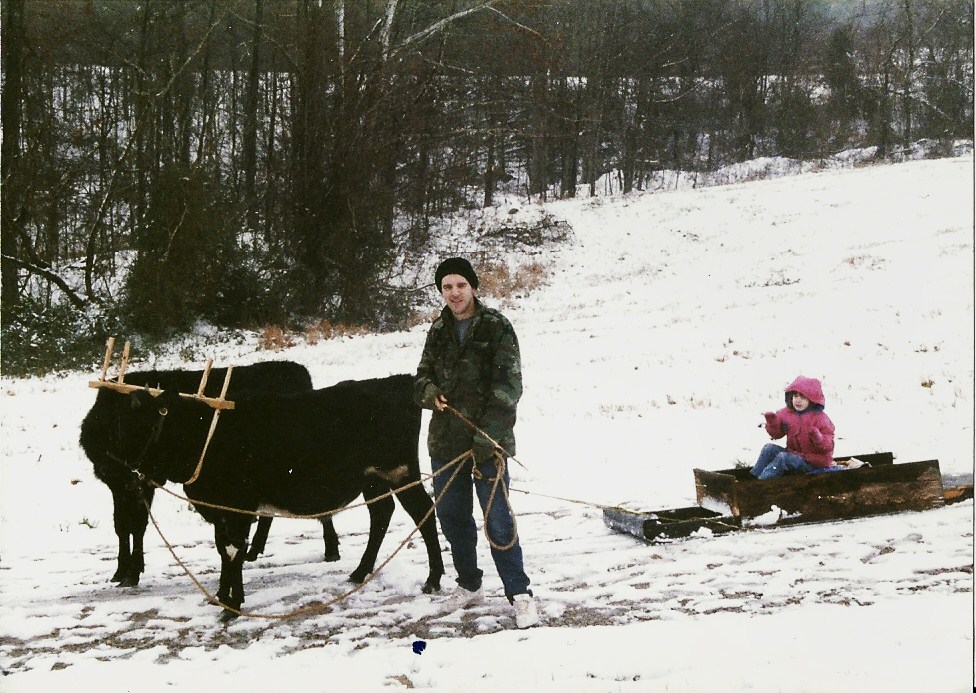
A few weeks later, after spending about an hour every morning with each calf, they were as capable of executing my commands together as they had been separately. In fact, much of the time I was able to work them without lines, relying on voice commands only. What fun. Everything was getting along so well, that I had thoughts of becoming a vegetarian. However the notion was quickly dismissed, given my weakness for pork and fried chicken. I’ll admit, there were challenging times; days when it was best to just take the yoke back off and go inside before I lost my temper. But even when one or the other (or both) acted out of line it was usually a great opportunity for further training…all dependent upon my reaction to their behavior. As a wise teamster once said, “If you’re with ’em, you’re trainin’ ’em…either for better or worse.”
The Real Thing…a Traditional Yoke
Several months and about 700 lbs later (them, not me), they had outgrown their second set of bows and yoke; necks swelling in the bows, and bellies brushing against each other. It was time to quit playing around with two by fours, and attempt the construction of my first version of the real thing.
There’s a lot of science, skill, and sometimes just good guesswork that has gone into much of what’s been written about making yokes. I found a yoke pattern that suited me…and about a 20-inch ash tree that did, too. Splitting off much of the unneeded outer bark and sides, I then used a chainsaw for roughing out. Taking off everything that didn’t look like my pattern, the image of a traditional yoke soon emerged. It was at that point I switched to a hatchet for the finer work, and finally…sandpaper.

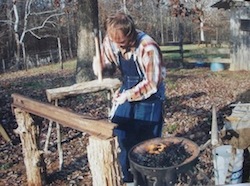
(above left) whittling down to size with hatchet; (above right) Drilling holes for bows and hardware; (inset) One of the beauties of oxen and yokes: Making your own hardware; (left) The finished product of the ox drover’s art
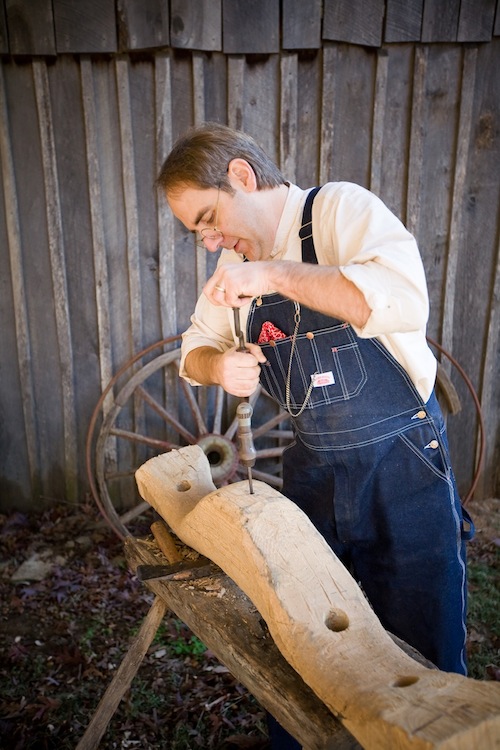
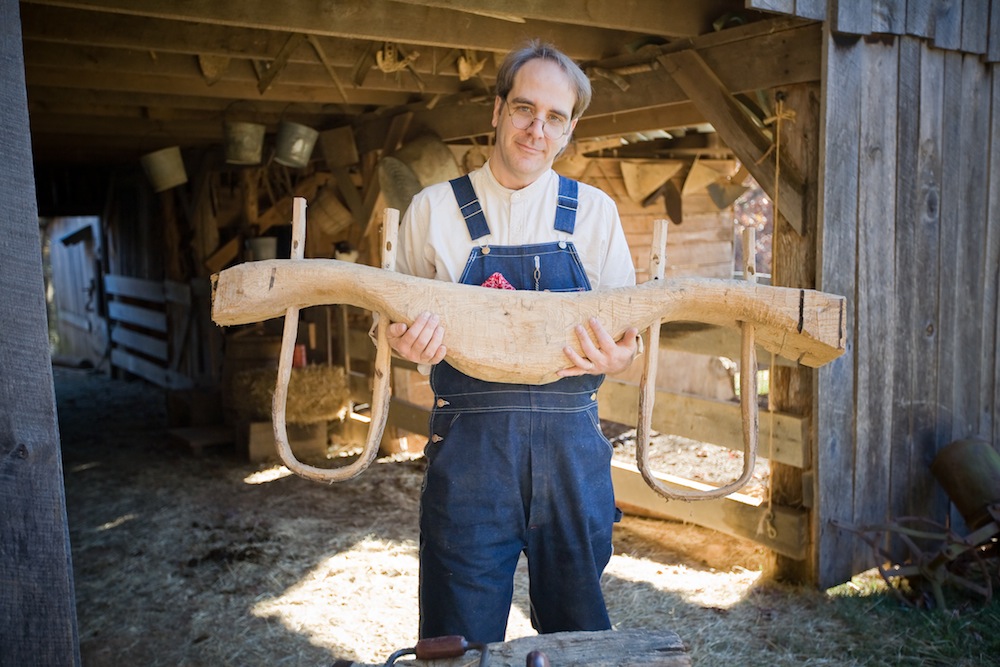
To the Work
Maybe it was just me projecting some excitement about putting on their new yoke, but I just promise you, I think they were a little excited to have the real thing, too. I could see it in their big bovine eyes. The rest was history.
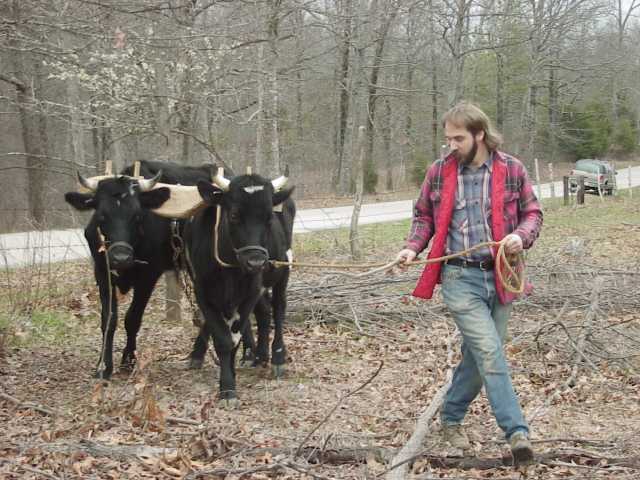
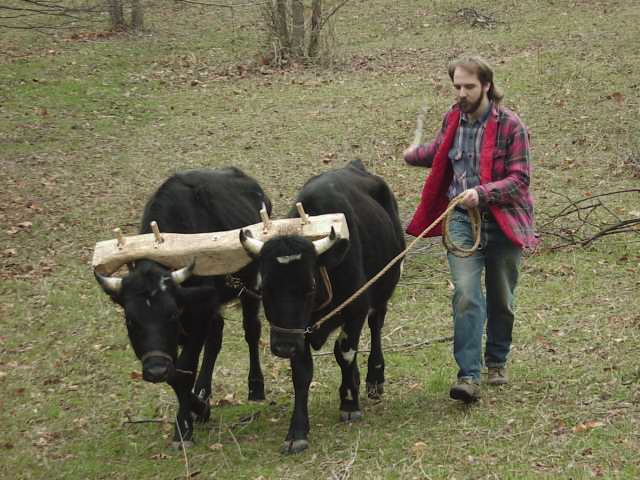
An afternoon of removing cut brush and trees from the fence line
Before I conclude, may I attempt to briefly describe to you this unparalleled experience to the senses brought about by the working of steers? The sound of cloven hooves on dirt, the metallic rattling of chain and hook, the creaking, wood-on-wood sound of bow and yoke, the pulling of a load, the smell of cattle…all for the accomplishment of work through the teaming of man and beast.

For me, the big draws to working steers or oxen are these: calves with good potential are relatively easy to find, not terribly expensive, fairly simple and straightforward to break or train, not too prone to sickness…and if you’re the least bit handy with tools and wood you can make your own gear from scratch. Now that’s farmin’.
As in the beginning stages of constructing the yoke, in this writing I’ve attempted to rough out the basics of my first journey with oxen, sadly leaving out much of the finer aspects and beauties of the experience. I’d like to think you may be looking forward to similar experiences of your own with this age-old camaraderie of bovine and mankind. Someday, perhaps, we’ll revisit the subject…taking a hatchet and some sandpaper to the details.
By Pa Mac
Article and photos copyright 2012, Caddo Heritage Productions
Also posted on:
The Backyard Farming Connection
The HomeAcre Hop
